Human Climate Niche Mapped
Homo sapiens, like every other organism on our planet, has its own niche. A comfortable temperature for humans ranges from 17°C to 24°C (62.6 to 75.2 °F). Within that temperature span, the ideal, especially for young and older people, is 22 to 23 °C (72 to 73°F), but it could be some degrees lower with high humidity and some degrees higher with low humidity. Mild heat strain starts at about 23°C (73.4°F) with high humidity or about 27°C (80.6°F) with low humidity. At medium humidity, heat strain is considered to be severe at 32°C (89.6°F), very severe at 36°C (96.8°F), and extreme at temperatures higher than 40°C (104°F), which can be lethal. Of course, people bear much hotter or colder weather, but there is a limit. Almost everybody finds city temperatures above 30 °C (86 °F) unacceptably hot. And people feel that days which don’t get above 17 °C (63 °F) are unpleasantly cold, at least for a leisure that’s not focussed on winter sports. Both cold and hot temperatures may have short-term effects on heart rate and blood pressure. Some studies even show that people who grew up in regions with more mild temperatures closer to 22 °C (71.6°F) scored higher on personality factors linked to socialization and stability (agreeableness, emotional stability, conscientiousness) and personal growth and plasticity (extraversion and openness to experience).
Regarding the climatic zones, the most significant number of days with comfortable temperatures for human life is found mainly in the subtropics. But climatic conditions comfortable for the human body are not the only condition for the progress of human societies. Historically, the emergence of progressive societies is confined to areas with climatic conditions that are comfortable not only for human habitation but also for the growth and habitat of economically important plants and animals. Therefore, I would say that the article below refers not only to the niche of Homo sapiens alone but rather to the niche of a community of humans, domesticated animals, and plants as a kind of “super-organism,” which, for example, can be called Homo agricultures.
Dutch research ecologist Marten Scheffer and his colleagues at the Santa Fe Institute and Wageningen University researched the history of global temperature, human population, and land-use estimates from the mid-Holocene period, starting about 6 thousand years ago to current times.
Researchers discovered that people, crops, and livestock had concentrated heavily in a narrow range of comparatively restricted climate conditions. This range referred to in the analysis as the “human climate niche,” has remained primarily unchanging since 6,000 years ago.
These 6,000 years of human history reveal how society thrives when we remain within it and the instability that occurs when it is moved out of these climatic zones.
According to the research, the optimum conditions for human civilization to flourish have a mean annual temperature of 11 to 15° C (51.8 to 59 °F). The ideal average temperature for national economic success is 13°C (55.4°F). Overall economic productivity is non-linear in temperature for all nations, with productivity culminating at an annual average temperature of 13 °C and decreasing strongly at higher temperatures.
The contemporary production of crops and livestock is mainly limited to the same climatic conditions, and the exact optimum has been seen for agricultural and nonagricultural economic output of nations through analyses of year-to-year variation.
Table of Contents
The Optimum conditions for human society to flourish
For mapping territories with mean annual temperature from 11°C to 15°C (51.8 to 59 °F), I used the raster image of the bioclimatic variable of Annual Mean Temperature (BIO1). According to the map globally, the Earth’s surface area with optimal conditions for human society to flourish is about 7.7 million square kilometers or 3,0 million square miles.
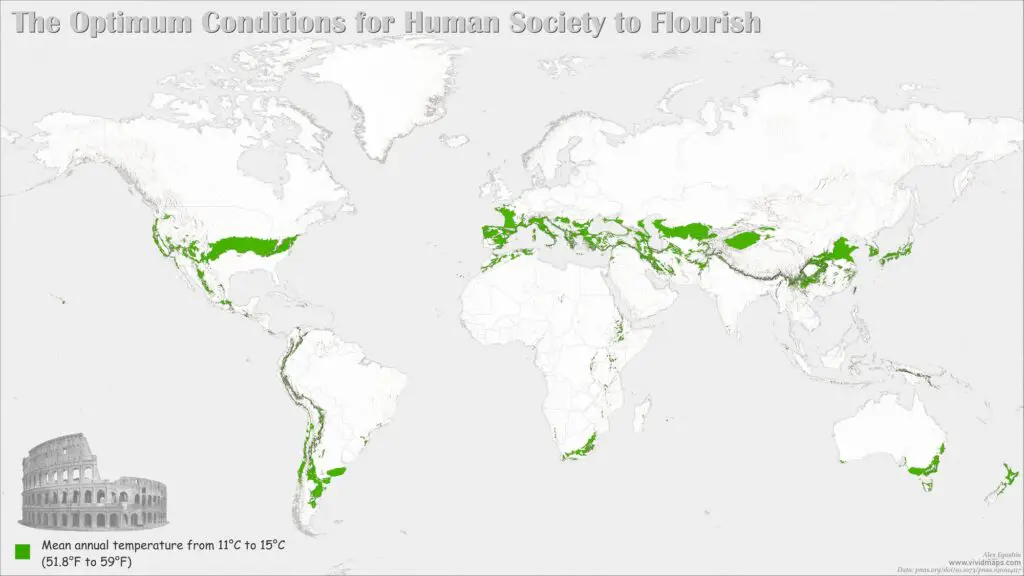
Countries by area of land with optimal conditions for human society to flourish
The wealthiest country in the world with the highest GDP, the United States, has the largest area with the optimum conditions for human society to flourish. Second place in the ranking of countries with optimal climatic conditions for flourishing humanity is the world’s second economy–China.
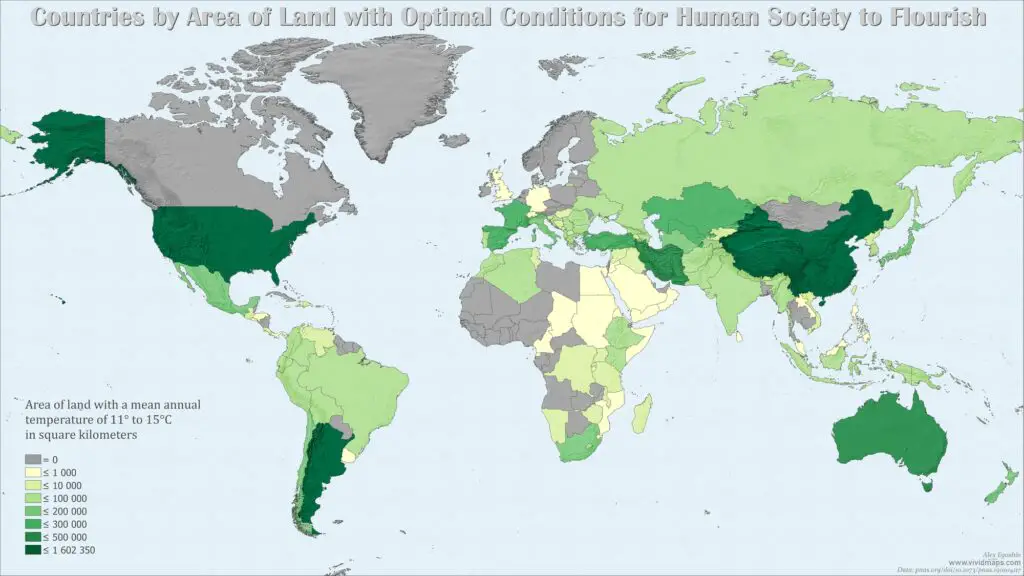
The top 10 countries with the most significant area with the optimum conditions for human society to flourish
| Rank | Country | Area in sq km | Area in sq mi |
|---|---|---|---|
| 1 | United States | 1,602,350 | 618,671 |
| 2 | China | 1,390,310 | 536,802 |
| 3 | Argentina | 512,823 | 198,002 |
| 4 | Iran | 350,084 | 135,168 |
| 5 | Australia | 308,044 | 118,936 |
| 6 | Uzbekistan | 276,460 | 106,742 |
| 7 | Spain | 268,074 | 103,504 |
| 8 | Turkey | 247,142 | 95,422 |
| 9 | France | 238,614 | 92,129 |
| 10 | Kazakhstan | 231,363 | 89,330 |
Below is the map of the percentage of land areas with optimal conditions for humanity to flourish by country, according to the research of Marten Scheffer and his colleagues.
Percentage of land areas with optimal conditions for human society to flourish by country
Uzbekistan, the birthplace of one of the world’s ancient civilizations, has the highest percentage of land areas with the optimum conditions for human society to flourish.
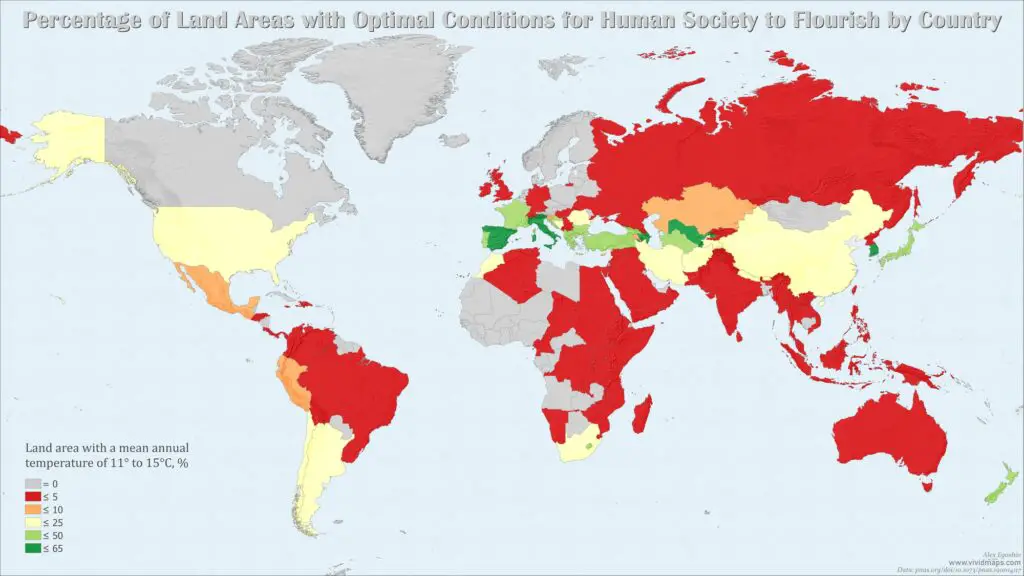
The top 10 countries with the highest percentage of land areas with the optimum conditions for human society to flourish
| Rank | Country | Percentage |
|---|---|---|
| 1 | Uzbekistan | 65 |
| 2 | Azerbaijan | 64 |
| 3 | South Korea | 59 |
| 4 | Italy | 55 |
| 5 | Monaco | 55 |
| 6 | Spain | 54 |
| 7 | Bulgaria | 50 |
| 8 | Greece | 49 |
| 9 | Lesotho | 48 |
| 10 | France | 43 |
Land area with optimal conditions for human society to flourish per capita by country
Below is the map of a land area with optimal conditions for human society to flourish per capita and the map of countries by the number of people per square kilometer of land area with optimal climatic conditions for human society to flourish.
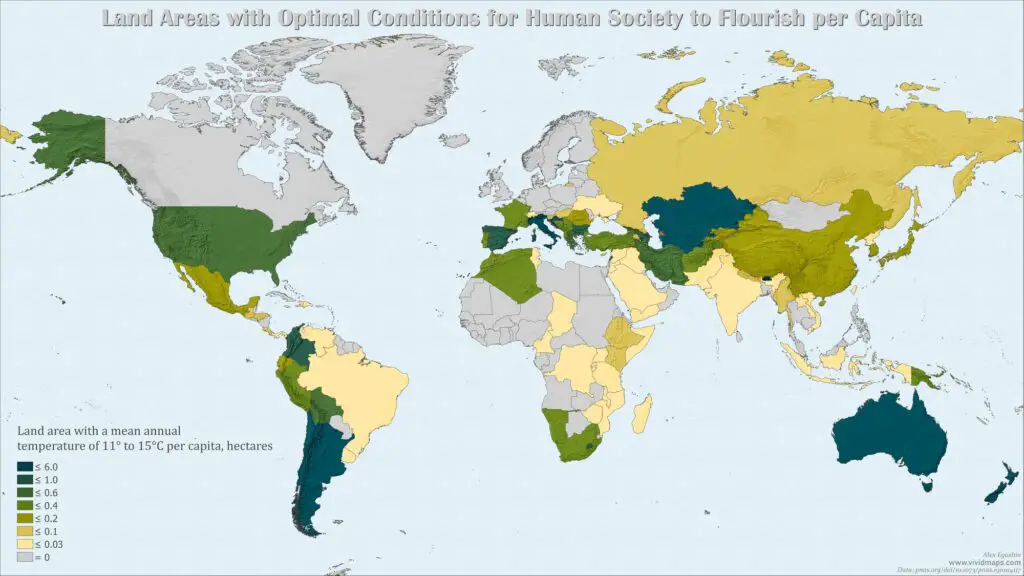
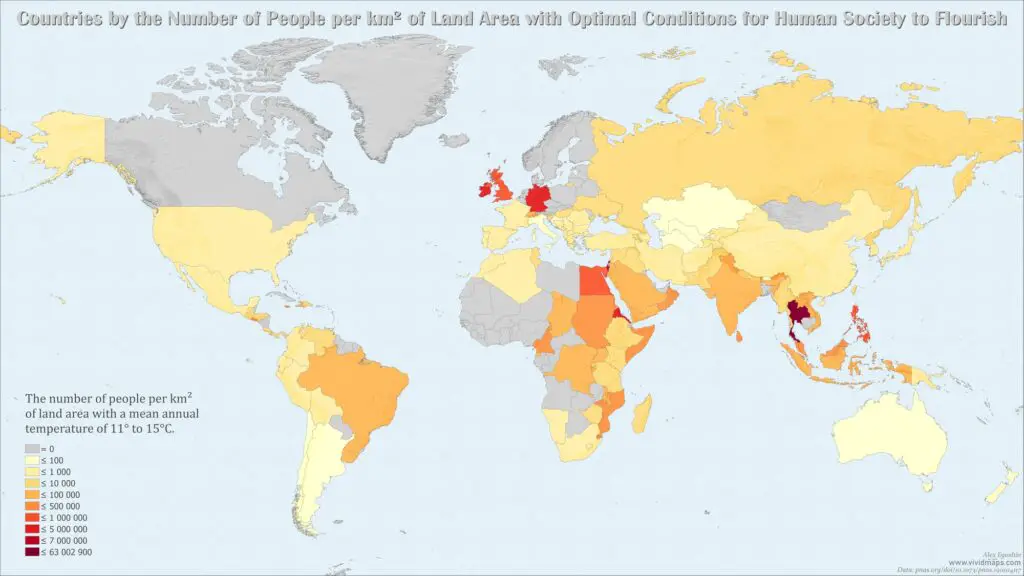
Full-size maps you can find here and here.
The top 10 countries with the largest land areas with the optimum conditions for human society to flourish per capita
| Rank | Country | Area in hectares per person |
|---|---|---|
| 1 | Croatia | 5.3 |
| 2 | Monaco | 3.4 |
| 3 | Turkmenistan | 2.9 |
| 4 | Italy | 2.8 |
| 5 | New Zealand | 2.6 |
| 6 | Kazakhstan | 1.5 |
| 7 | Australia | 1.5 |
| 8 | Argentina | 1.3 |
| 9 | Uzbekistan | 1.0 |
| 10 | Chile | 1.0 |
Even nowadays, despite the many technological advances that have helped us create comfortable conditions even in the earth’s most inhospitable regions, the climate continues to influence the development of civilization, as it did thousands of years ago. But as the climate changes, the territories that fit within the human climate niche will also change.
Further warming will harm the economies of many countries, especially those that are densely populated. Such countries as India, Indonesia, Brazil, and Nigeria are already much warmer, representing the impact of climate change on their economic growth will be even greater. Nowadays, about 0.8% of the planet’s surface experiences mean annual temperatures above 29° Celsius (84.2°F), especially in the Sahara region of Africa. However, with forecasted rises in global average surface temperatures, this area is expected to enlarge significantly to cover almost 19% of the global land. According to some research, a result of climate change that shifts climatic zones would leave 1 – 3 billion people outside the climate conditions that have nurtured human society to date. This would not be a massive problem if few people lived in that part of the world, but it is one of the world’s fastest-growing areas.
According to the researchers, the human climate niche is projected to shift remarkably to higher latitudes. So at present, the United Kingdom and Germany are cooler than 13°C, meaning their economies may improve slightly as temperatures increase.
The maps below show how the optimum conditions for human society to flourish will change by the end of the 21st century
The Optimum conditions for human society to flourish in 2100
By 2100, Europe’s climate, except for the southern part, will be even more comfortable. The zone with the most comfortable climate in North America will be mainly located along the border between the United States and Canada.
For creating the map below, I used future climate data from the Coupled Model Intercomparison Project Phase 6 (CMIP6) for the general circulation model MIROC6 and climate projection ssp585.
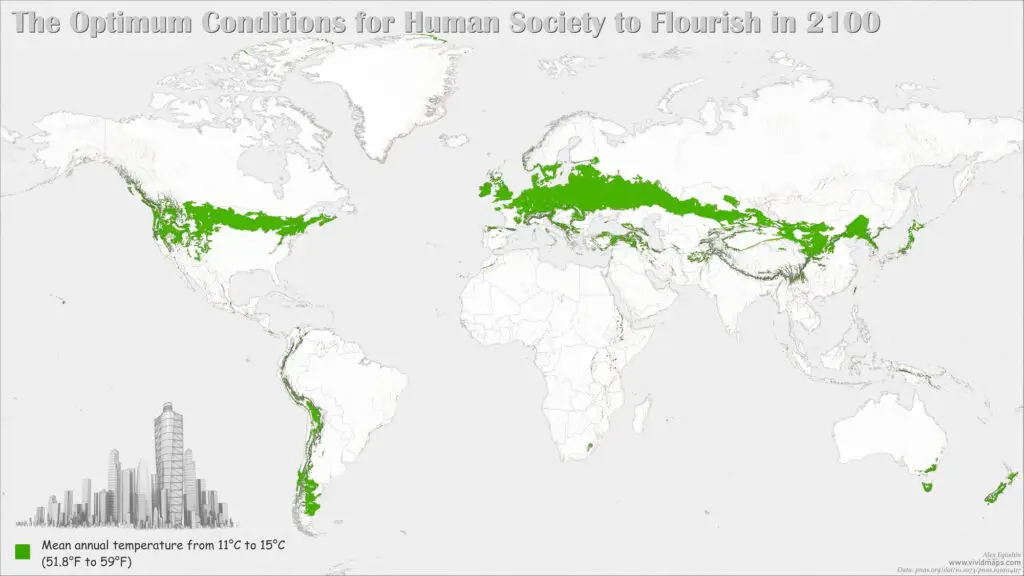
Globally, the Earth’s surface area with optimal conditions for human society to flourish will increase by 32% from 7,738,067 to 11,390,271 square kilometers (from 2,987,684 to 4,397,808 sq mi).

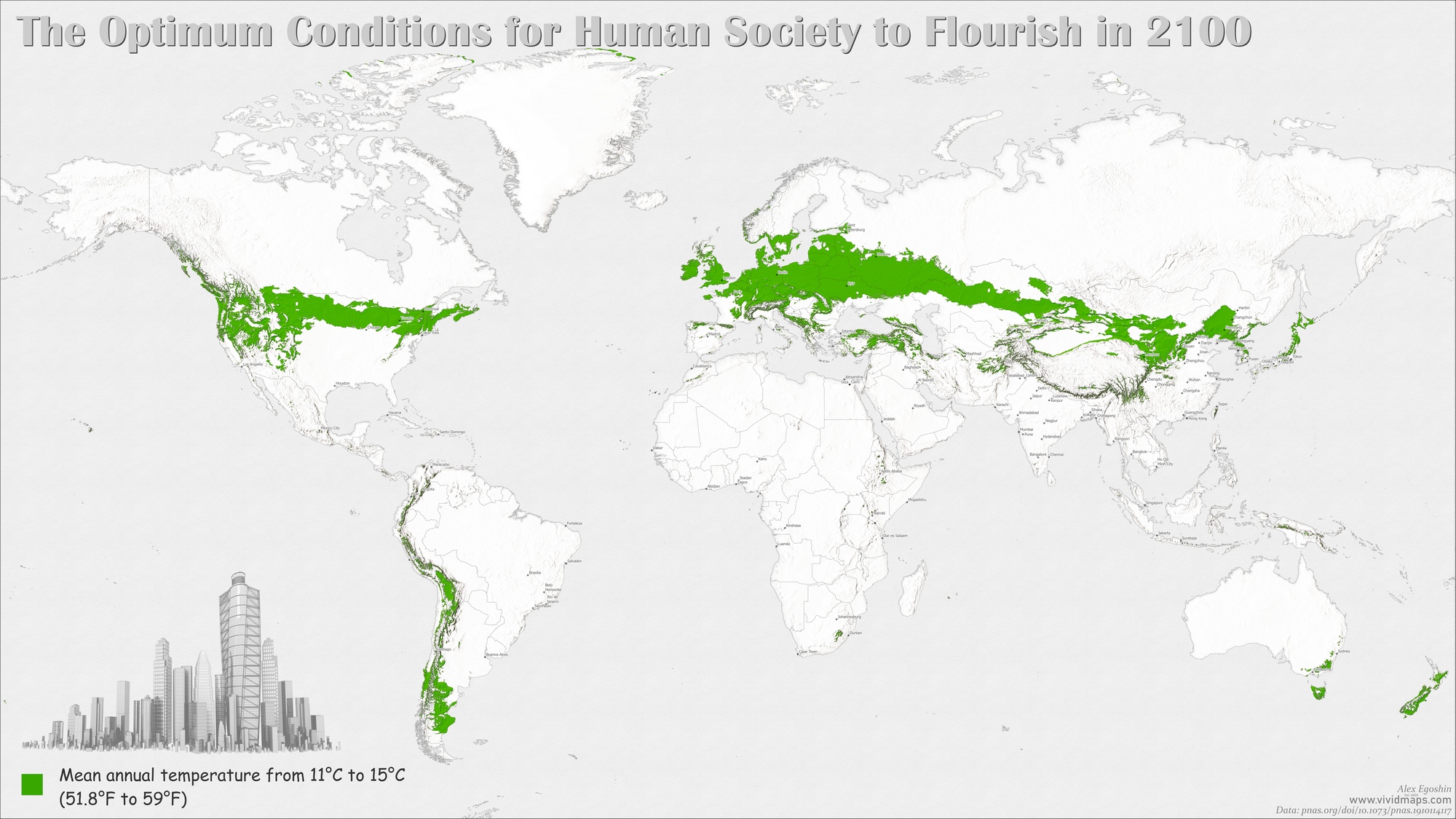
Countries by area of land with optimal conditions for human society to flourish in 2100
By the end of the 21st century, the United States, China, Russia, and Kazakhstan will have the most expansive territories with a comfortable climate for life and economic development.
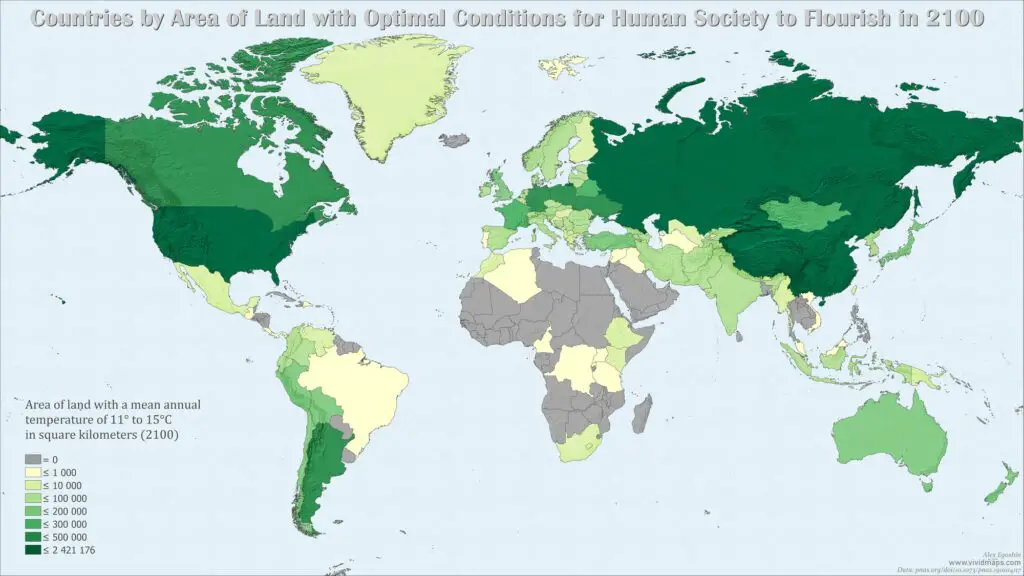
The top 10 countries with the most significant area with the optimum conditions for human society to flourish in 2100
| Rank | Country | Area in sq km | Area in sq mi |
|---|---|---|---|
| 1 | United States | 2,421,176 | 934,821 |
| 2 | China | 1,639,005 | 632,823 |
| 3 | Russia | 1,151,595 | 444,633 |
| 4 | Kazakhstan | 1,018,858 | 393,383 |
| 5 | Argentina | 453,201 | 174,982 |
| 6 | Canada | 447,391 | 172,739 |
| 7 | Ukraine | 414,358 | 159,985 |
| 8 | Germany | 346,801 | 133,902 |
| 9 | Poland | 308,660 | 119,174 |
| 10 | Mongolia | 252,961 | 97,669 |
Percentage of land areas with optimal conditions for human society to flourish by country in 2100
Climatic changes will also benefit northern, central, and eastern Europe. The territories of some European countries will be almost entirely in the zone with optimal climatic conditions for human society to flourish.
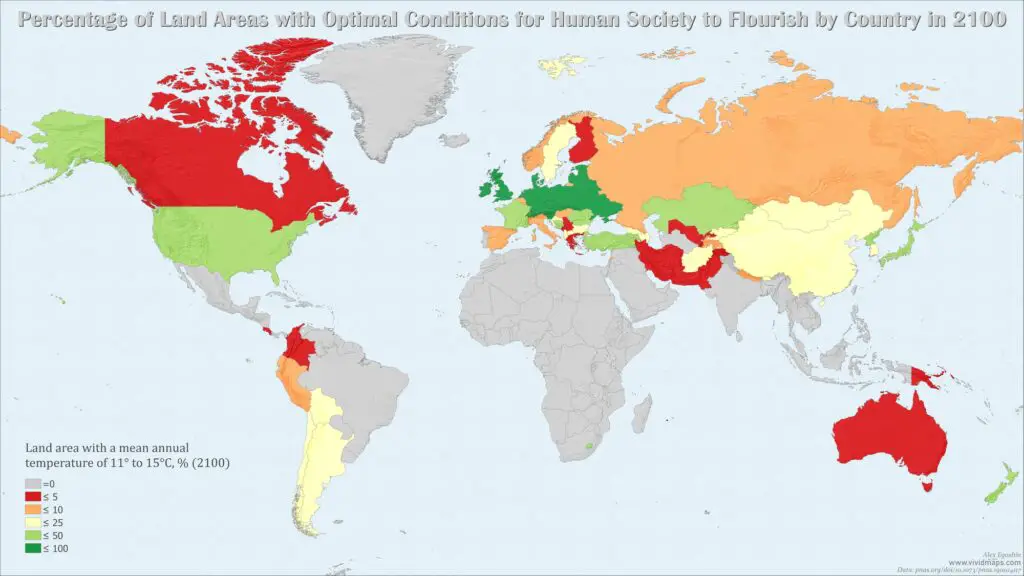
The top 10 countries with the highest percentage of land areas with the optimum conditions for human society to flourish in 2100
| Rank | Country | Percentage |
|---|---|---|
| 1 | Netherlands | 100 |
| 2 | Estonia | 99 |
| 3 | Lithuania | 98 |
| 4 | Poland | 96 |
| 5 | Belarus | 95 |
| 6 | Germany | 94 |
| 7 | Denmark | 93 |
| 8 | Ireland | 91 |
| 9 | Latvia | 91 |
| 10 | Czech Republic | 90 |
Land area with optimal conditions for human society to flourish per capita by country in 2100
The UN forecasts that world population growth will slow considerably for the 21st century, coming near to its peak at 10.9 billion by 2100. The most populous countries in 2100 will still be China and India. There will be 1.4 billion people in each of these countries.
Unfortunately, the climate of the most densely populated countries in Asia and Africa will become less comfortable for living and economic development.
Below is the map of a land area with optimal conditions for human society to flourish per capita and the map of countries by the number of people per square kilometer of land area with optimal conditions for human society to flourish by the end of the 21st century created using UN data on the projected population in 2100.
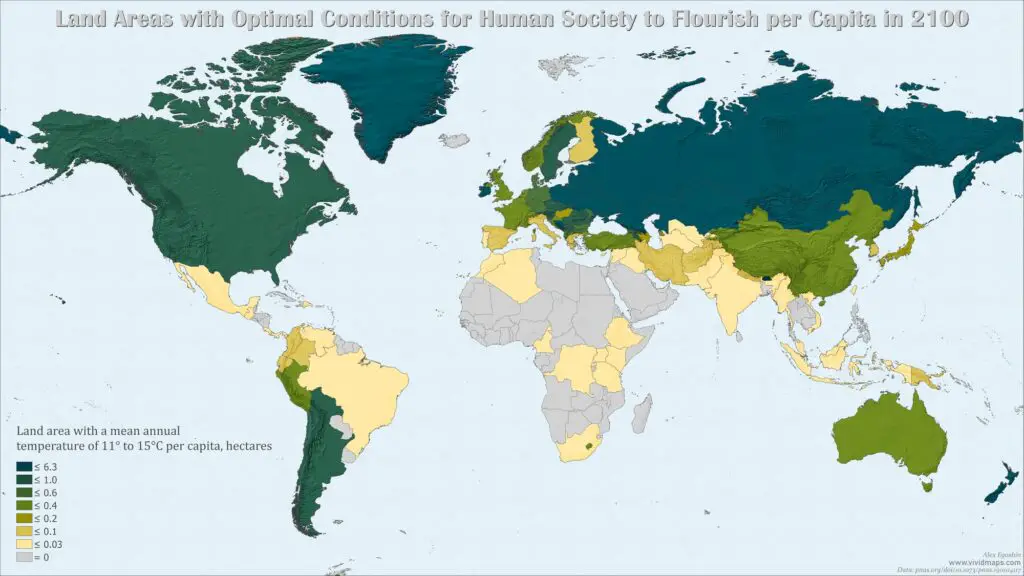
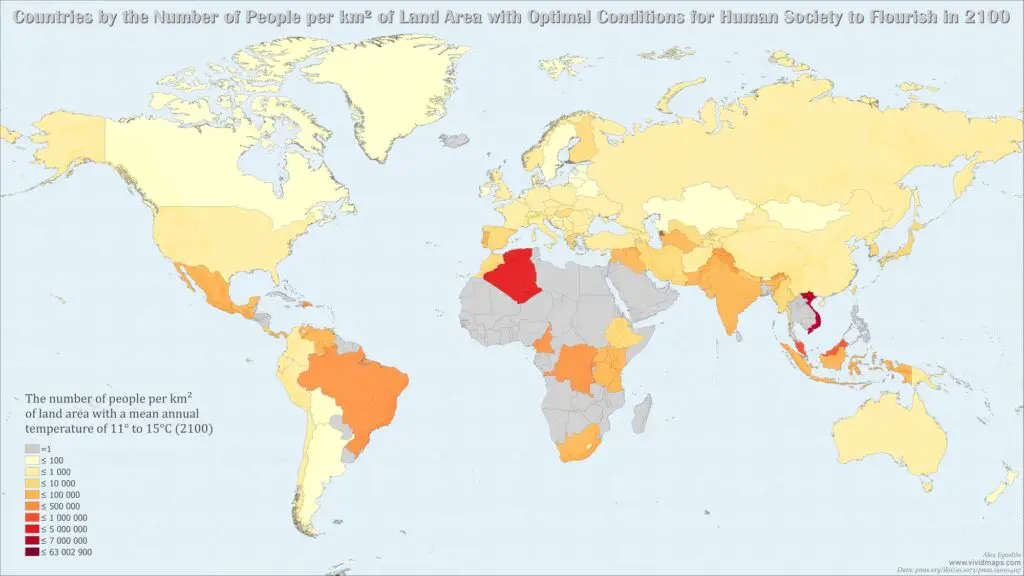
Full-size maps you can find here and here.
The sparsely populated countries of northern and eastern Europe will benefit from the increase in the average annual temperature.
The top 10 countries with the largest land areas with the optimum conditions for human society to flourish per capita in 2100
| Rank | Countries | Area in hectares per person |
|---|---|---|
| 1 | Latvia | 6.2 |
| 2 | Greenland | 5.7 |
| 3 | Estonia | 5.3 |
| 4 | Mongolia | 4.8 |
| 5 | Lithuania | 4.3 |
| 6 | Belarus | 3.2 |
| 7 | Kazakhstan | 3.0 |
| 8 | New Zealand | 2.1 |
| 9 | Ukraine | 2.0 |
| 10 | Montenegro | 1.6 |
Expected Net Area Change of Land with Optimal Conditions for Human Society to Flourish per capita to 2100
In absolute numbers, Russia, the U.S., and Kazakhstan will benefit most from climate change, while Iran, Uzbekistan, Spain, and Australia will lose the most.
If we consider the change in the area of territories with the most comfortable climatic conditions per capita, the European countries will primarily benefit.
Below are the maps that show the expected net area change of land with optimal conditions for human society to flourish in total (map on the left) and per capita (map on the right) by 2100.
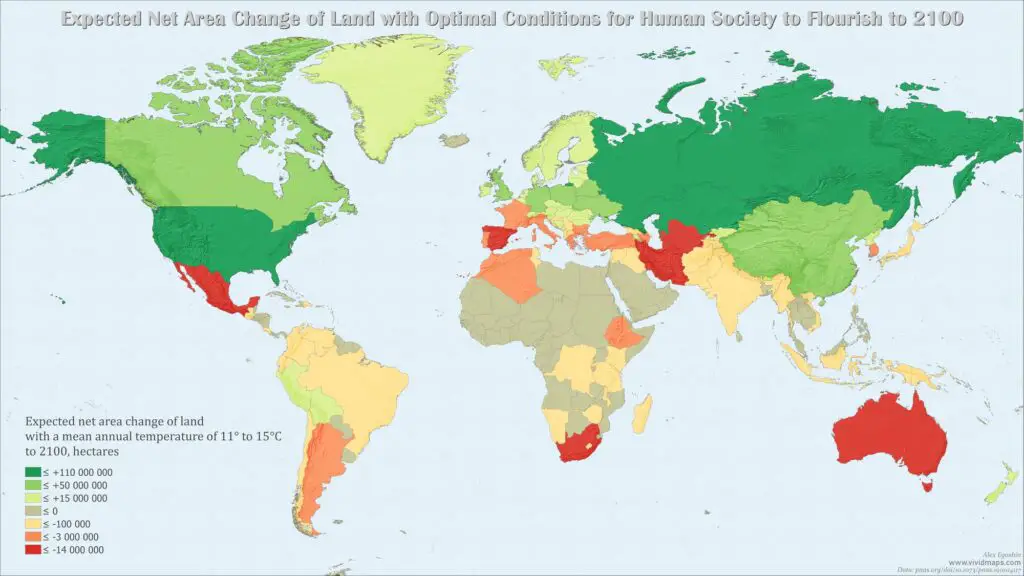
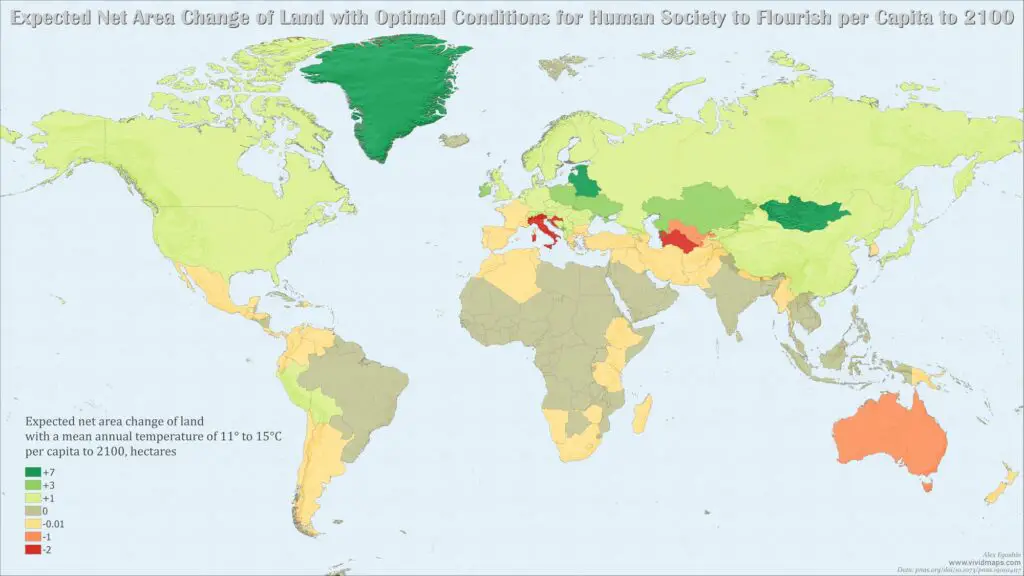
Top 10 countries with the highest and lowest growth of an area of land with optimal conditions for human society in hectares by 2100
| Rank | Country | Change in an area in hectares by 2100 | Rank | Country | Change in an area in hectares by 2100 |
| 1 | Russia | +108 964 000 | 1 | Iran | -28 917 900 |
| 2 | United States | +81 882 600 | 2 | Uzbekistan | -26 883 600 |
| 3 | Kazakhstan | +78 749 500 | 3 | Spain | -23 903 100 |
| 4 | Canada | +44 739 100 | 4 | Australia | -20 661 700 |
| 5 | Ukraine | +40 049 300 | 5 | South Africa | -16 861 100 |
| 6 | Germany | +34 677 100 | 6 | Mexico | -16 004 600 |
| 7 | Poland | +30 866 000 | 7 | Turkmenistan | -14 018 300 |
| 8 | Mongolia | +25 296 100 | 8 | Italy | -13 912 400 |
| 9 | China | +24 869 500 | 9 | Algeria | -7 454 600 |
| 10 | Belarus | +20 771 800 | 10 | Morocco | -6 434 800 |
Top 10 countries with the highest and lowest growth of an area of land with optimal conditions for human society in hectares per person by 2100
| Rank | Country | Change in an area in hectares per person by 2100 | Rank | Country | Change in an area in hectares per person by 2100 |
| 1 | Latvia | +6.2 | 1 | Croatia | -5.0 |
| 2 | Greenland | +5.7 | 2 | Monaco | -3.4 |
| 3 | Estonia | +5.3 | 3 | Turkmenistan | -2.9 |
| 4 | Mongolia | +4.8 | 4 | Italy | -2.7 |
| 5 | Lithuania | +4.3 | 5 | Australia | -1.3 |
| 6 | Belarus | +3.2 | 6 | Uzbekistan | -1.0 |
| 7 | Ukraine | +1.9 | 7 | Colombia | -0.9 |
| 8 | Kazakhstan | +1.5 | 8 | Lebanon | -0.6 |
| 9 | Poland | +1.3 | 9 | Spain | -0.5 |
| 10 | Montenegro | +1.2 | 10 | Azerbaijan | -0.5 |
According to the researchers, business-as-usual climate change scenario, the geographical position of this temperature niche is forecasted to shift more over the coming 50 years than it has shifted since 6000 BP. As a result, climate change’s effect will massively increase global income inequality and reshape the global economy by decreasing average global incomes by roughly 23% by 2100. Populations will not simply track the shifting climate; adaptation in situ may address some challenges, and many other factors affect migration decisions.





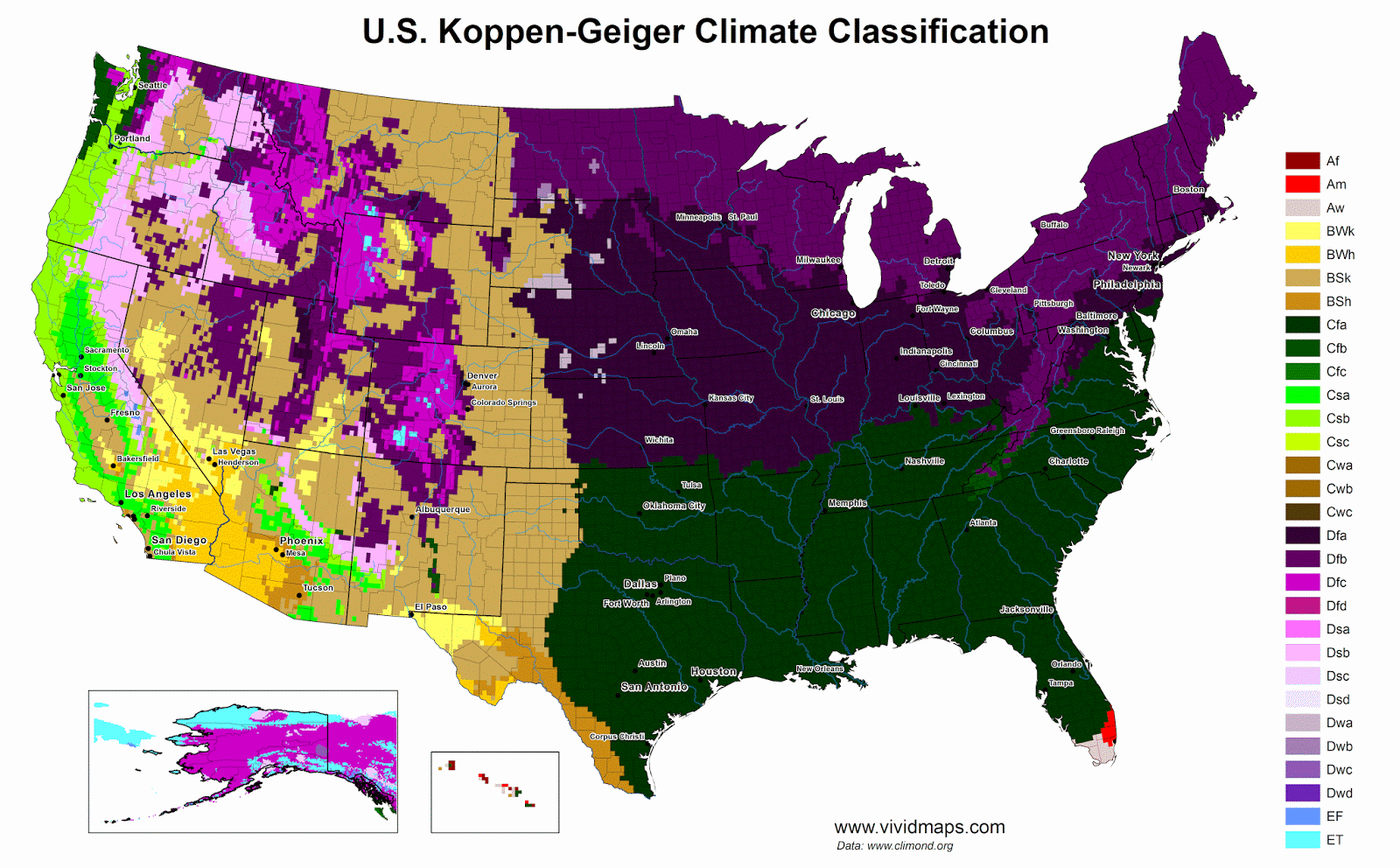


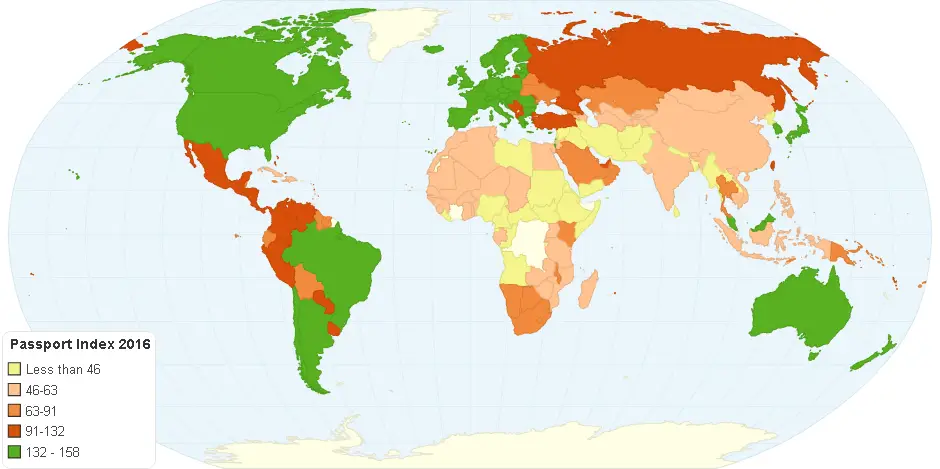
The fact that the “zone” for wonderful human living would basically cover all of central and most of the southern Nordics is astonishing to me.
Almaty (Kazakhstan)
January: −4.6°С (23.7°F)
July: 24.4°С (75.9°F)
Tashkent (Uzbekistan)
January: 1.9°С (35.4°F)
July: 27.8°С (82.0°F)
There is no doubt about Central Asia. This is where ancient civilizations have originated for the last 6,000 years. In Samarkand, the first astronomical observatory was built in the 15th century.
https://en.wikipedia.org/wiki/Ulugh_Beg_Observatory
Samarkand (Uzbekistan)
January: 1.9 (35.4)
July: 26.8°С (80.2°F)
The only thing I have doubts about is the Taklamakan Desert. Although there are publications that an ancient civilization existed there as well.
https://www.zju.edu.cn/english/2022/0110/c19573a2474359/page.htm
This is not true. The average temperature in Almaty is much higher. You can find information about the climate of this city here.
https://en.wikipedia.org/wiki/Almaty
Climate of other cities in Kazakhstan, which are located on the coast of the Caspian Sea
Fort-Shevchenko
https://en.wikipedia.org/wiki/Fort-Shevchenko
Aktau
https://en.wikipedia.org/wiki/Aktau
Weather in Almaty in January (the coldest month of the year) is mild, with an average daytime temperature of -3 … 4 degrees and dropping to -10 degrees at night.
Nevertheless, I agree that the citation of Alma-Ata is not entirely successful. Because according to the map, this city does not actually fall into the zone with a comfortable climate, marked in green.
https://www.flickr.com/photos/vividmaps/52646698011/sizes/o/
No one is talking about the entire territory of Uzbekistan. There are cities in this country with a quite comfortable climate (Samarkand, Bukhara, etc.). Even if you look at the Russian version of Wikipedia, you can see that. It is no coincidence that cities such as Samarkand and Bukhara were hotbeds of ancient civilizations in their time. In those days, mankind was more dependent on climate than now.
ok, I’ll go the other way. a quick glance at Google map is enough to make sure that the territory of Central Asia is sands and steppes, where there is sparse vegetation, poor wildlife. little moisture. How can a person live comfortably in such a climate? The Caspian Sea is not deep, it warms up quickly in summer and cools down quickly in winter without giving thermoregulation, as does the ocean, and deeper seas that store heat.
If you take Samarkand, the climate there is dry subtropics, quite comfortable for human life.
http://samarkand-guide.narod.ru/klima.html
http://elib.rshu.ru/files_books/pdf/img-125123223.pdf
Just interesting the habitable areas for humans in theory are not actually the most densely populated. Americans are moving to those areas south of the habitable zone. Argentines stick to Buenos Aires. The most habitable areas of France and Spain are some the emptiest in those countries. It seems like Italians, Koreans, and Japanese settle where they’re “supposed to”.
It should also be considered that when civilizations began, humanity depended more on the climate. Nowadays, with the development of technology and economy, we can live in more extreme conditions. Climate has had less influence on the well-being of human societies.
Sure, but any adaptation will cost you energy, time and heatth issues. So in the end of the day you will be competed out.
The authors did not consider 2 important factors that limit human living at northern latitudes. The first one is daylight, its variability at high latitude both in summer and winter limits regular human life. The winter lack of daylight above 55 degrees latitude is known to cause depression. Finally also plants limit their growth due to day light limits. Harvests at northern latitudes are limited to maximum 1 per year. Related to this issue is the lack of fertile soils at northern latitudes. Weathering processes made them acid and the recent glaciations made them not fully developed. Soil development takes in the order of 1000 years using natural processes. Artificialy speeded up can be done but requires large amounts of energy and is unlikely to be profitable.
Forget about Western Europe. They will experience terrible problems with major flooding events. Many lands are simply below water level. This is not taken into account in the study. Proximity to the Sea isnt not in their benefit.
The average is not a particularly good criterion. North-Dakota may have an interesting average, but the extreme continental temperatures without mountains to make a barrier to polar wind in winter makes it poorly populated for a good reason.
Very interesting maps. Thx!

It would be interesting to recalibrate results based on human life before ‘civilization’; i.e. before agriculture and animal domestication. IOW, if you are naked, and you need year-round food supply directly from nature, where is the best climate to live? That would be our species’ original home: tropical rainforests.
Another point: In tropical rainforests, temperatures tend to remain within a very narrow range, unlike continental temperate regions. This narrow range would be far more comfortable throughout the year.
This would require coordinates from the earliest Homo sapiens fossil sites, historical climate data from WorldClim, and then MaxENT modeling to generate the maps.